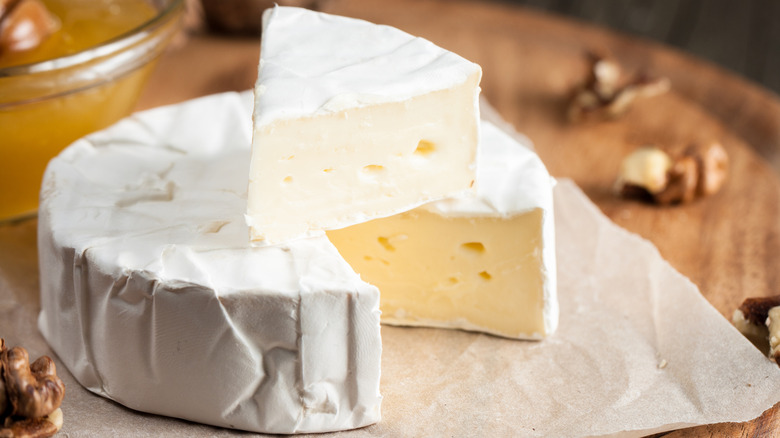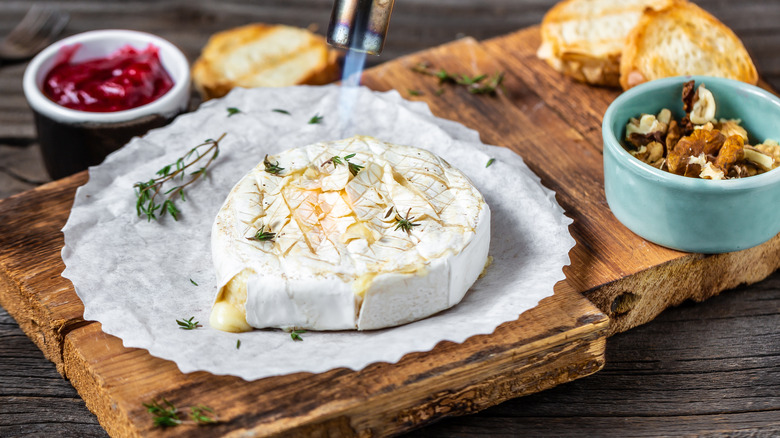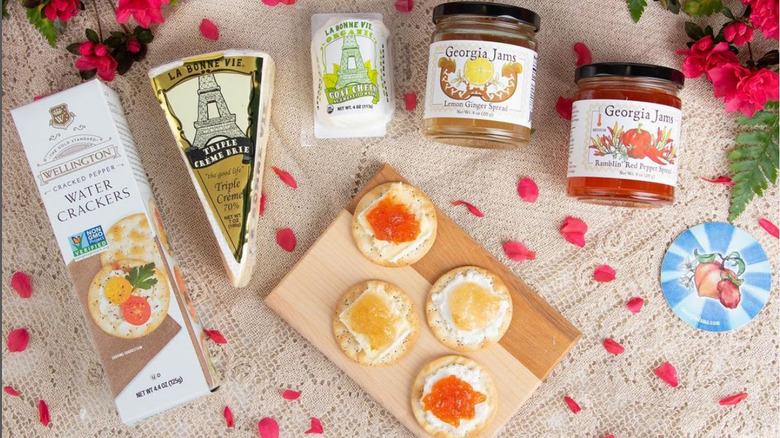How To Serve And Eat Brie Like An Expert
Buttery, nutty, and mild, Brie is considered a soft-ripened cheese. That means that it's aged (i.e., ripened) through the application of mold to its outer layer. This has the effect of causing the cheese to mature from the outside inward. In the process, it develops its familiar "bloomy rind," which is fully edible and tastes a lot like the Brie's interior, only more intensely so. Many cheese experts maintain that the longer a wheel of Brie is allowed to age before slicing into it, the better. That's because as Brie ripens, it develops a deeper and earthier taste, and its interior grows softer, if not thickly runny. On the other hand, breaking through the rind halts the ripening process.
This might appear to suggest that the first decision to make when serving and eating Brie is how long to wait, after purchase, before indulging. In fact, that is true for most of the Brie purchased outside the U.S. But most of what is sold as Brie in the U.S. is stabilized before sale — because that's what U.S. law. requires. This has the effect of stopping the aging process before the cheese has fully ripened.
Accordingly, there's no reason not to serve and eat your U.S.-sourced Brie as soon as you get it home from the grocery store. But that's just the first of several best practices that apply to serving and eating Brie.
Your Brie game deserves a proper warmup
You're welcome to serve your Brie straight out of the refrigerator. But experts maintain that Brie's flavors, aromas, and texture are at their best when allowed to come to, at least, room temperature before serving. In terms of planning ahead, you should be aware that this could take up to an hour or more.
However, you can accelerate the process somewhat by zipping the wedge you're serving into a zip-top bag (or, if you have a vacuum sealer, you can use that) and then submerging it in water warmed to just above room temperature. If you happen to have a sous vide cooking contraption handy, that makes the task even easier. Simply set the cooker to 80 degrees Fahrenheit and check back every half hour or so until your still-wrapped cheese feels as warm to the touch as its water bath.
To accelerate the process even further, you can microwave a wedge of Brie. But you'll want to do so at intervals of no more than 30 to 60 seconds at a time, unless, of course, your goal is to melt it. Alternatively, you can circumvent the whole "warming to room temperature" thing by baking Brie in an oven set to 350 degrees Fahrenheit for 15 to 25 minutes. This easy Fig Baked Brie Recipe promises next level goodness by contrasting the cheese's nutty umami pungency with the opulent sweetness of fresh figs.
The expert approach to slicing Brie
When serving Brie, especially if you're including it as part of a well-executed charcuterie board, you may need to cut it down to a manageable size before serving. When starting with a wheel of Brie, your first cut should divide the circle in half. Continue halving the halves until you arrive at the size wedge you need. If you're starting with a wedge, you can size it down, as needed, by slicing off wedge-shaped lengths — going from the outer rind to the point/tip of the wedge.
Most experts recommend serving Brie with the rind still on, unless you're planning on using your Brie in a recipe that requires otherwise. When serving Brie to a group, place it on a cutting board with a soft-cheese knife/spreader, and get the ball rolling by slicing a few "example" pieces. Or feel free to pre-slice into individual bite-size slices. However, this becomes more challenging if the Brie is particularly soft and runny.
Whatever you aren't planning on using should be wrapped tightly in plastic wrap (or vacuum sealed) and stored in the fridge, where it will remain fresh for up to a week, per the USDA. However, you'll want to discard any Brie that's been sitting outside the fridge for four or more hours, per Clemson University Extension.
What to serve with your brie
Brie's buttery flavor generally pairs well with wine's acidity, but this is especially true with regard to full-bodied chardonnays, crisp pinot noirs, and Champagnes. On the other hand, the best fruits for pairing with Brie tend to the less acidic and straight-up sweeter. These include apples, pears, stone fruits, grapes, and dates. Similarly, the sweetness of drizzled honey can offer a nice contrast to Brie's creaminess. The same is true of jams and preserves, including those that lean toward the savory (such as an onion jam) or the tart (such as cranberry relish).
Because Brie is soft, it goes particularly well with crisp and crunchy accoutrements, including crackers, crusty French bread, and shelled nuts. It also melts well for an elevated grilled cheese or these stuffed burgers, albeit with the rind removed. Finally, Brie works well as a rind-on slice for sandwiches (e.g., turkey or roast beef) with a slice or two of tomato for a cool, slightly acidic contrast.



